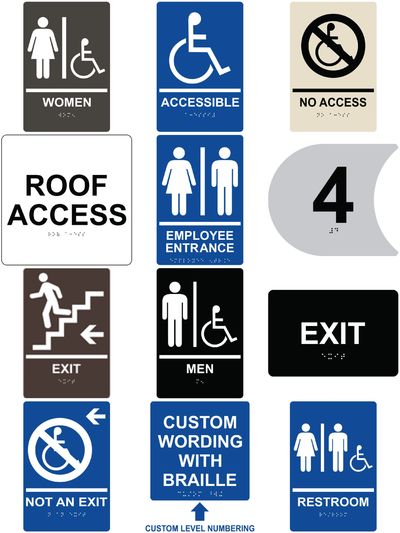The Impact of ADA Signs on Neighborhood Availability
Discovering the Secret Functions of ADA Signs for Enhanced Accessibility
In the world of ease of access, ADA indications serve as silent yet effective allies, guaranteeing that areas are navigable and inclusive for people with specials needs. By integrating Braille and tactile elements, these signs damage obstacles for the aesthetically impaired, while high-contrast color plans and clear fonts provide to varied visual requirements.
Importance of ADA Compliance
Guaranteeing conformity with the Americans with Disabilities Act (ADA) is essential for cultivating inclusivity and equivalent access in public rooms and offices. The ADA, passed in 1990, mandates that all public facilities, employers, and transportation solutions suit individuals with specials needs, ensuring they take pleasure in the same legal rights and possibilities as others. Compliance with ADA standards not just satisfies legal commitments but additionally boosts an organization's credibility by showing its commitment to diversity and inclusivity.
Among the essential elements of ADA compliance is the application of accessible signage. ADA signs are designed to guarantee that individuals with handicaps can quickly navigate with buildings and areas. These signs have to comply with specific standards concerning dimension, typeface, shade comparison, and positioning to ensure exposure and readability for all. Correctly implemented ADA signs helps remove barriers that people with impairments often encounter, therefore promoting their freedom and self-confidence (ADA Signs).
Additionally, adhering to ADA laws can minimize the risk of legal effects and potential penalties. Organizations that stop working to abide with ADA standards may face legal actions or charges, which can be both damaging and monetarily difficult to their public photo. Thus, ADA compliance is integral to fostering a fair atmosphere for every person.
Braille and Tactile Aspects
The incorporation of Braille and tactile aspects into ADA signage embodies the concepts of accessibility and inclusivity. These functions are critical for people who are blind or aesthetically impaired, enabling them to browse public spaces with better independence and confidence. Braille, a responsive writing system, is necessary in giving written info in a layout that can be conveniently perceived through touch. It is usually positioned underneath the equivalent message on signs to ensure that individuals can access the information without aesthetic help.
Tactile elements extend past Braille and consist of elevated symbols and characters. These parts are developed to be noticeable by touch, permitting people to identify area numbers, bathrooms, departures, and other vital areas. The ADA sets specific guidelines regarding the size, spacing, and positioning of these tactile components to optimize readability and ensure uniformity throughout different settings.

High-Contrast Color Design
High-contrast color pattern play an essential duty in enhancing the visibility and readability of ADA signs for people with aesthetic problems. These systems are crucial as they maximize the difference in light reflectance in between text and my response history, making sure that indications are conveniently discernible, also from a range. The Americans with Disabilities Act (ADA) mandates using certain color contrasts to suit those with restricted vision, making it a critical aspect of compliance.
The efficiency of high-contrast colors depends on their capacity to stand out in different illumination problems, including poorly lit environments and locations with glare. Commonly, dark text on a light history or this article light message on a dark history is used to attain optimal comparison. Black text on a white or yellow background offers a plain visual distinction that helps in fast acknowledgment and comprehension.

Legible Fonts and Text Dimension
When taking into consideration the style of ADA signage, the option of clear typefaces and ideal text dimension can not be overemphasized. The Americans with Disabilities Act (ADA) mandates that fonts need to be not italic and sans-serif, oblique, manuscript, very decorative, or of uncommon type.
The size of the message additionally plays a pivotal function in accessibility. According to ADA standards, the minimum message height need to be 5/8 inch, and it must increase proportionally with viewing distance. This is especially essential in public areas where signage needs to be read rapidly and accurately. Uniformity in message size contributes to a cohesive visual experience, assisting people in navigating atmospheres successfully.
Moreover, spacing between letters and lines is indispensable to legibility. Adequate spacing avoids personalities from appearing crowded, improving readability. By adhering to these criteria, designers can substantially improve ease of access, making sure that signs offers its desired purpose for all individuals, no matter of their visual capabilities.
Reliable Placement Methods
Strategic placement of ADA signs is important for making the most of ease of access and making certain conformity with lawful criteria. ADA guidelines state that signs must be mounted at an elevation in between 48 to 60 inches from the ground to ensure they are within the line of view for both standing and seated address individuals.
Furthermore, signs need to be put adjacent to the lock side of doors to enable very easy identification prior to entrance. Consistency in sign placement throughout a facility enhances predictability, reducing complication and enhancing overall customer experience.

Final Thought
ADA indications play an essential duty in promoting accessibility by integrating functions that attend to the needs of individuals with disabilities. Incorporating Braille and responsive components ensures crucial info comes to the aesthetically damaged, while high-contrast color design and understandable sans-serif font styles enhance exposure across different lighting conditions. Efficient positioning approaches, such as proper installing elevations and critical places, further help with navigation. These elements collectively foster a comprehensive atmosphere, emphasizing the importance of ADA conformity in ensuring equal gain access to for all.
In the world of access, ADA indications offer as quiet yet powerful allies, guaranteeing that areas are comprehensive and navigable for individuals with handicaps. The ADA, enacted in 1990, mandates that all public facilities, employers, and transport solutions suit individuals with disabilities, guaranteeing they appreciate the very same civil liberties and opportunities as others. ADA Signs. ADA indications are developed to ensure that people with impairments can conveniently navigate via structures and spaces. ADA standards specify that signs ought to be installed at an elevation between 48 to 60 inches from the ground to ensure they are within the line of view for both standing and seated individuals.ADA indications play an important function in promoting ease of access by incorporating attributes that deal with the needs of individuals with specials needs